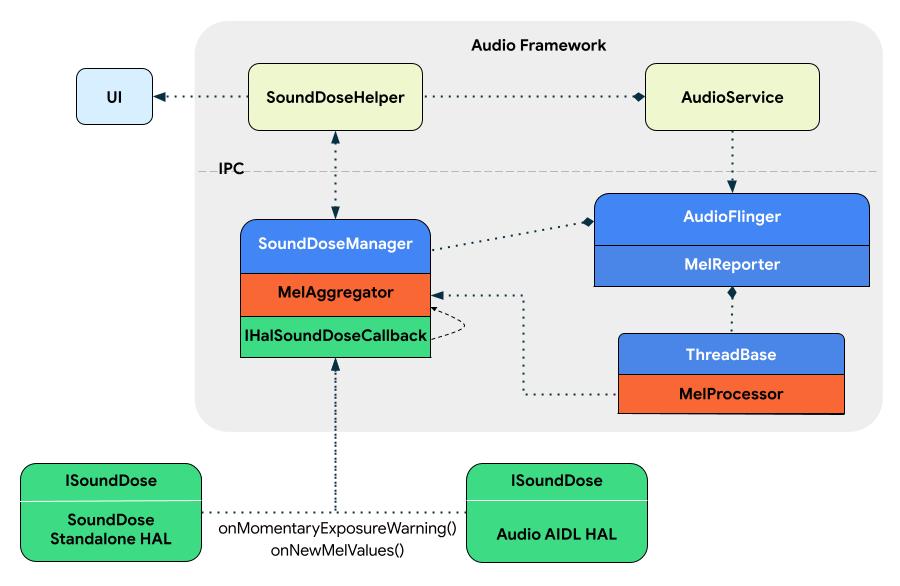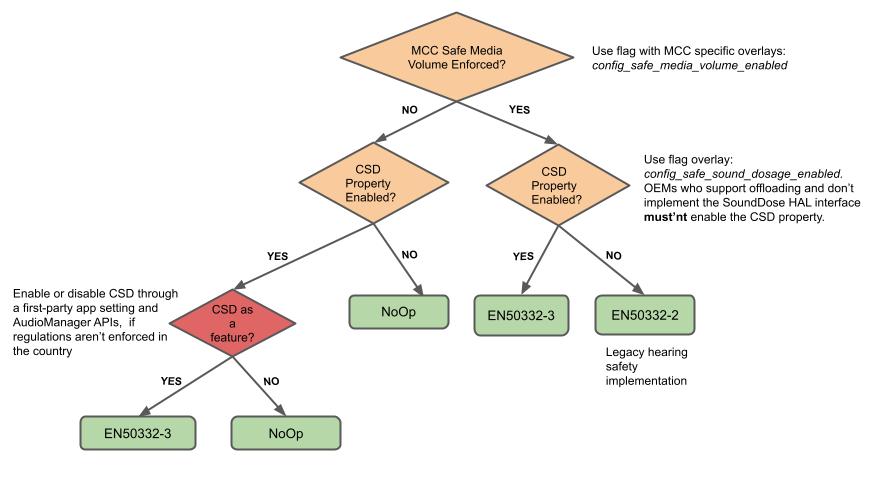Android 14 通过持续监控声音剂量测量值并在用户受到有害暴露水平时发出警告,从而在音频框架和音频 HAL 中提供对声音剂量的支持。
声音剂量是随时间推移的声音压力级测量值。通过监控声音剂量,我们可以帮助保护用户免受过度或长时间声音暴露的有害影响,从而在使用便携式 Android 设备上的耳机时提供更好的听力保护,并最大限度地降低听力受损的可能性。
新的安全听音设备标准符合 IEC62368-1 第 3 版(需要登录)和 EN50332-3(仅限订阅者访问)中的听力保护监管要求,这些标准引入了声音剂量的概念。
声音剂量功能让 OEM 厂商可以遵循新的听力安全法规。为了支持声音剂量,OEM 厂商必须遵循所有自定义项和认证的接口规范和法规。自定义的 OEM 实现可以绕过或修改 AOSP 声音剂量的默认实现。但是,强烈建议使用 AOSP 实现。
声音剂量计算
IEC62368-1 第 3 版和 EN50332-3 中的标准通过计算计算声音剂量 (CSD) 提高了测量声音暴露的准确性。CSD 通过随时间积分瞬时暴露水平 (MEL) 来计算。为声音剂量计算维护一个七天连续滚动的累积 CSD 值窗口。
根据 IEC62368-1 第 3 版的 10.6.3.2 节,如果 CSD 值达到 100% 限制,系统会在每次增加 100% 时向用户发出声音级别警告。如果用户未确认警告,则音量会降低到 IEC62368-1 表 39 的预定义辐射能量源等级 1 (RS1) 值。
如 IEC62368-1 第 3 版的 10.6.3.3 节所述,除了声音剂量警告外,系统还必须在每次 MEL 值超过 IEC62368-1 表 39 的辐射能量源等级 2 (RS2) 值时启动基于暴露的警告。
为了通过这些法规的认证并使 CSD 值更具相关性,系统必须使用用户感知到的准确输出值(例如媒体播放输出)。对于 CSD 计算而言,重要的是使用接近用户实际暴露的声音压力级的值。
架构
取决于帧捕获的位置,硬件特性和传感器效应会影响渲染帧的功率级别。为了获得精确的输出声压级测量值,我们扩展了 HAL 以直接从底层硬件获取 MEL 值,并考虑数字信号处理器 (DSP) 或扬声器属性(例如阻抗、灵敏度和频率响应)可能应用的效果。
如果 HAL 无法提供 MEL 值,作为后备机制,音频框架会分析和计算 CSD。音频框架中的此计算基于从 HAL 报告的关于渲染输出的信息,以及发送到音频 DSP 的帧。
声剂量引入了两个组件:SoundDoseHelper 和 SoundDoseManager,如图 1 所示

图 1. 声剂量功能的架构组件。
SoundDoseHelper
SoundDoseHelper 类位于 systemserver 进程中,是所有相关声音剂量数据的主要收集点。AudioService 类管理 SoundDoseHelper 类。
SoundDoseHelper 类负责以下事项:
- 处理新的剂量信息
- 持久化声音剂量值
- 在
audioserver崩溃时恢复状态 - 触发系统 UI 通知
- 降低音量
SoundDoseManager
SoundDoseManager 类位于 audioserver 进程中,是 AudioFlinger 类的一部分,它从 HAL 收集声音剂量数据,或者作为后备机制,从发送到 HAL 的帧中内部计算得出。SoundDoseManager 类将声音剂量数据发送到 SoundDoseHelper 类。
MelProcessor 和 MelAggregator
如果 HAL 无法提供 MEL 值,则使用 MelProcessor 和 MelAggregator 实用程序在 libaudioutils 中进行内部声音剂量计算。
在 MelProcessor 类中,主要计算是在包含音频样本的缓冲区上执行的,方法是调用 MelProcessor::process(const void* buffer, size_t bytes)。OEM 可以在其 HAL 实现中根据需要使用 MelProcessor。
MelAggregator 类从不同的音频端口接收 MEL 值,并使用七天的滚动窗口计算 CSD 值。方法 MelAggregator::aggregateAndAddNewMelRecord_l(MelRecord mel) 执行该逻辑。结果将发送到 SoundDoseManager 类,以便与 AudioService 通信。
实现
HIDL 接口扩展已从 Android 14 开始弃用,因此用于检索计算出的 MEL 值和发出暴露警告的新 HAL 接口(名为 ISoundDose)被定义为 AIDL 音频 HAL 的一部分。但是,对于需要更多时间来集成 AIDL 音频 HAL 的实现者,我们提供了一个独立的声剂量 AIDL HAL,它提供了 ISoundDoseFactory 接口。此接口将在未来弃用。
以下代码示例显示了用于声剂量支持的 HAL 方法
/**
* This interface provides functions related to sound exposure control required for compliance to
* EN/IEC 62368-1 3rd edition. Implementing this interface is mandatory for devices for which
* compliance to this standard is mandated and implementing audio offload decoding or other direct
* playback paths where volume control happens below the audio HAL.
*/
@VintfStability
interface ISoundDose {
/**
* Max value in dBA used for momentary exposure warnings as defined by IEC62368-1
* 3rd edition. This value represents the default RS2 upper bound.
*/
const int DEFAULT_MAX_RS2 = 100;
/** Min value of the RS2 threshold in dBA as defined by IEC62368-1 3rd edition. */
const int MIN_RS2 = 80;
/**
* Sets the RS2 upper bound used for momentary exposure warnings. Default value is
* DEFAULT_MAX_RS2 as specified in IEC62368-1 3rd edition.
*
* @param rs2ValueDbA custom RS2 upper bound to use
* @throws EX_ILLEGAL_ARGUMENT if rs2ValueDbA is greater than DEFAULT_MAX_RS2 or lower
* than MIN_RS2
*/
void setOutputRs2UpperBound(float rs2ValueDbA);
/**
* Gets the RS2 upper bound used for momentary exposure warnings.
*
* @return the RS2 upper bound in dBA
*/
float getOutputRs2UpperBound();
/**
* Registers the HAL callback for sound dose computation. If sound dose is supported
* the MEL values and exposure notifications will be received through this callback
* only. The internal framework MEL computation will be disabled.
* It is not possible to unregister the callback. The HAL is responsible to provide
* the MEL values throughout its lifecycle.
*
* @param callback to use when new updates are available for sound dose
*/
void registerSoundDoseCallback(in IHalSoundDoseCallback callback);
@VintfStability
oneway interface IHalSoundDoseCallback {
/**
* Called whenever the current MEL value exceeds the set RS2 upper bound.
*
* @param currentDbA the current MEL value which exceeds the RS2 upper bound
* @param audioDevice the audio device where the MEL exposure warning was recorded
*/
void onMomentaryExposureWarning(float currentDbA, in AudioDevice audioDevice);
@VintfStability
parcelable MelRecord {
/**
* Array of continuously recorded MEL values >= MIN_RS2 (1 per second).
* First value in the array was recorded at 'timestamp'.
*/
float[] melValues;
/**
* Corresponds to the time in seconds, as reported by CLOCK_MONOTONIC, when
* the first MEL entry in melValues was recorded. The timestamp values have
* to be consistent throughout all audio ports, equal timestamp values will
* be aggregated.
*/
long timestamp;
}
/**
* Provides a MelRecord containing continuous MEL values sorted by timestamp.
* Note that all the MEL values originate from the audio device specified by audioDevice.
* In case values from multiple devices need to be reported, the caller should execute
* this callback once for every device.
*
* @param melRecord contains the MEL values used for CSD
* @param audioDevice the audio device where the MEL values were recorded
*/
void onNewMelValues(in MelRecord melRecord, in AudioDevice audioDevice);
}
}
新的 HAL 接口实现了回调,这些回调会通知框架有关瞬时暴露的信息,并在输出电平超过 RS1 时提供 MEL 值。当实现这些接口后,框架会将它们用于 CSD 报告。如果没有此回调实现,则会使用 AudioFlinger 上的后备实现来计算 CSD 值的估计值。
独立的声剂量 AIDL 支持
在 OEM 可以将声剂量集成到 AIDL 音频 HAL 之前,他们可以使用独立的 AIDL API ISoundDoseFactory 作为权宜之计。ISoundDoseFactory 使用 ISoundDose 接口,如下面的代码示例所示
@VintfStability
interface ISoundDoseFactory {
/**
* Retrieve the sound dose interface for a given audio HAL module name.
*
* If a device must comply to IEC62368-1 3rd edition audio safety requirements and is
* implementing audio offload decoding or other direct playback paths where volume control
* happens below the audio HAL, it must return an instance of the ISoundDose interface.
* The same instance must be returned during the lifetime of the HAL module.
* If the HAL module does not support sound dose, null must be returned, without throwing
* any errors.
*
* @param module for which we trigger sound dose updates.
* @return An instance of the ISoundDose interface implementation.
* @throws EX_ILLEGAL_STATE If there was an error creating an instance.
*/
@nullable ISoundDose getSoundDose(in @utf8InCpp String module);
}
声剂量 AIDL 音频 HAL 支持
声剂量接口作为 AIDL 音频 HAL 的一部分长期受支持,通过扩展 IModule 接口来实现,如下面的代码示例所示
@VintfStability
interface IModule {
…
/**
* Retrieve the sound dose interface.
*
* If a device must comply to IEC62368-1 3rd edition audio safety requirements and is
* implementing audio offload decoding or other direct playback paths where volume control
* happens below the audio HAL, it must return an instance of the ISoundDose interface.
* The same instance must be returned during the lifetime of the HAL module.
* If the HAL module does not support sound dose, null must be returned, without throwing
* any errors.
*
* @return An instance of the ISoundDose interface implementation.
* @throws EX_ILLEGAL_STATE If there was an error creating an instance.
*/
@nullable ISoundDose getSoundDose();
}
此功能是 IEC62368-1 第 3 版和 EN50332-3 中描述的新法规的实现,因此没有对外 API。
OEM 可以通过实现新的 HAL 接口并为音频框架提供准确的 CSD MEL 数据(推荐),或通过提供自定义的声音剂量实现来认证其设备。
启用声剂量计算
默认情况下,AOSP 支持听力安全逻辑,该逻辑可确保通过现有的 EN50332-2 和 IEC62368-1 10.6.5 标准认证。
在 Android 14 中,默认情况下禁用声剂量计算。
使用以下指南来启用声剂量计算,从 Android 14-QPR1 开始。
如果您的国家/地区强制执行声剂量法规,请检查
config.xml中的config_safe_media_volume_enabled是否设置为true。为了符合 EN50332-3 和 IEC62368-1 10.6.3,供应商必须将
config.xml中的config_safe_sound_dosage_enabled标志覆盖为true。对于支持卸载解码且未实现声剂量 HAL 接口的设备,config_safe_sound_dosage_enabled不得设置为true。在这种情况下,将config_safe_sound_dosage_enabled设置为true可能会导致不准确的 CSD 值和安全听力标准的认证问题。
以下决策图描述了根据国家/地区限制和标志值,确定是计算 CSD 还是传统的听力安全级别(在 Android 14 之前实现)的逻辑。

图 2. 启用声剂量计算(逻辑在 Android 14-QPR1 中添加)。
验证
在实现声剂量 HAL 接口时,OEM 必须针对 VtsHalAudioCoreTargetTest(针对 IModule AIDL 音频 HAL 实现)或 VtsHalSoundDoseFactoryTargetTest(针对独立的声剂量 AIDL HAL 实现)定义的 VTS 测试用例进行验证。
